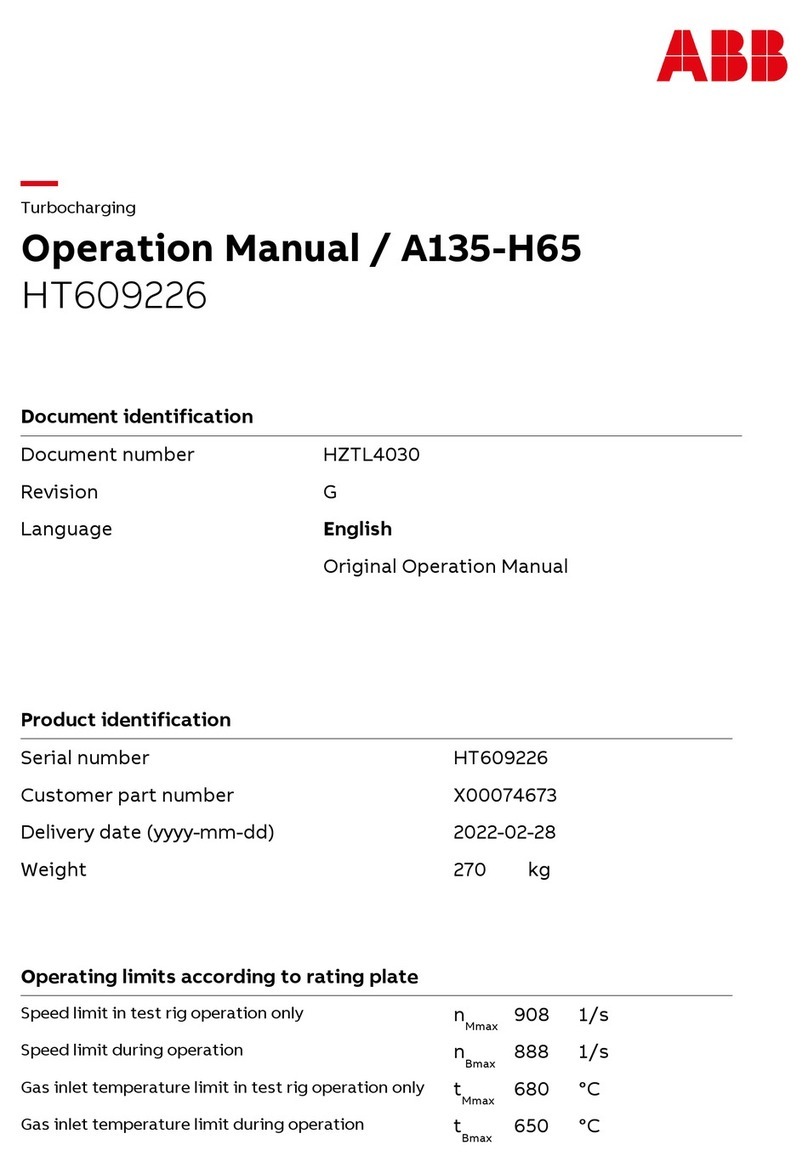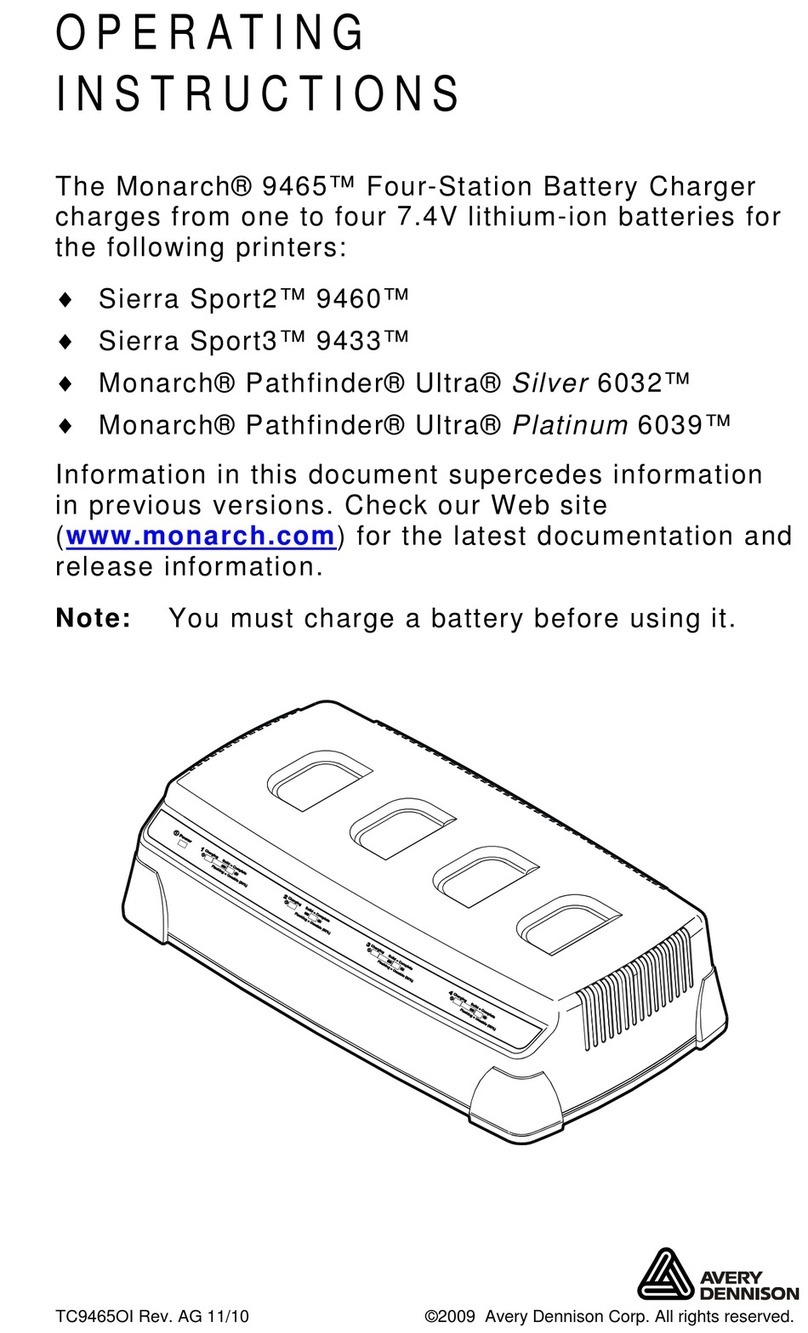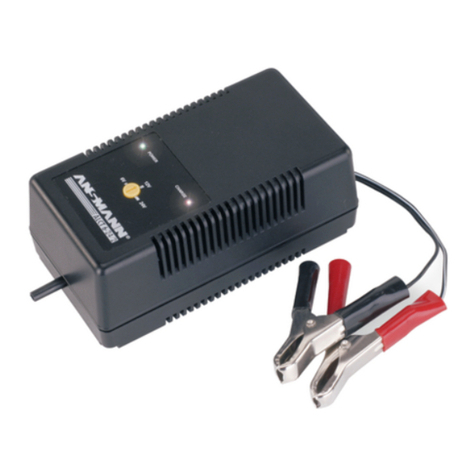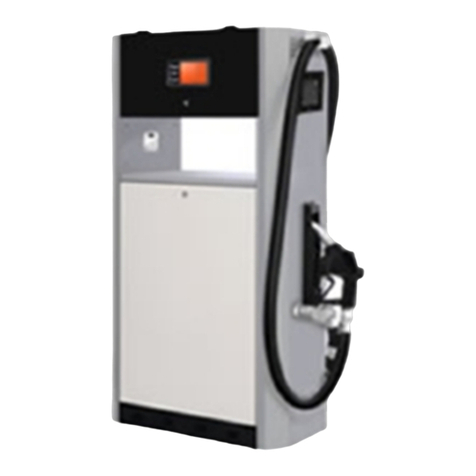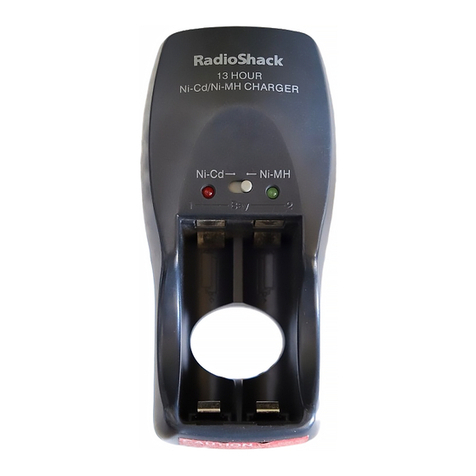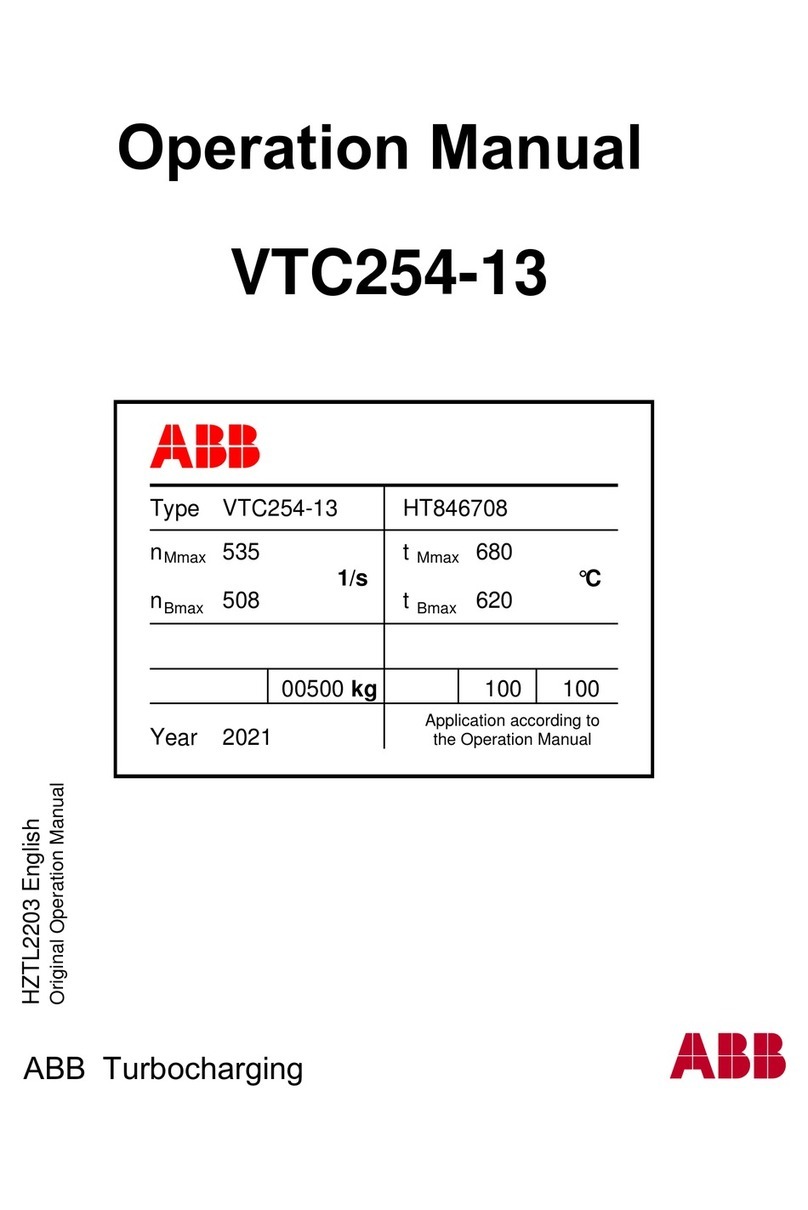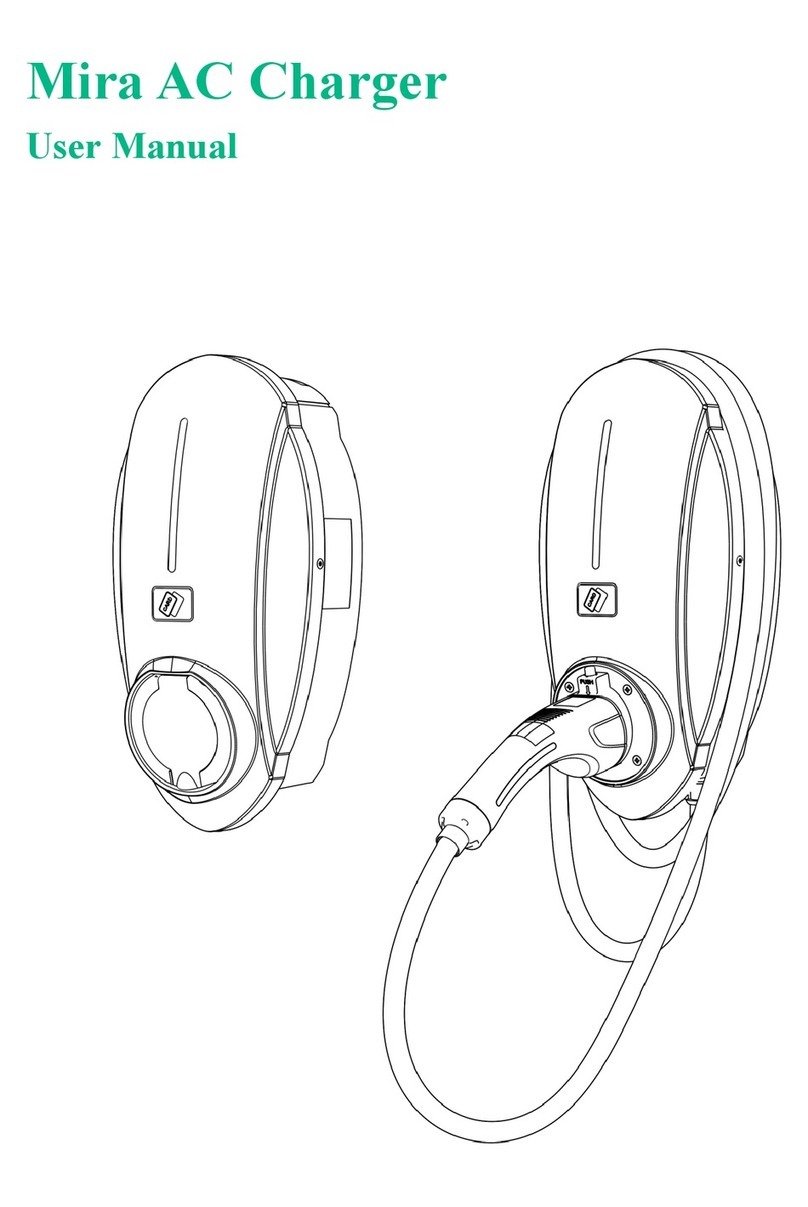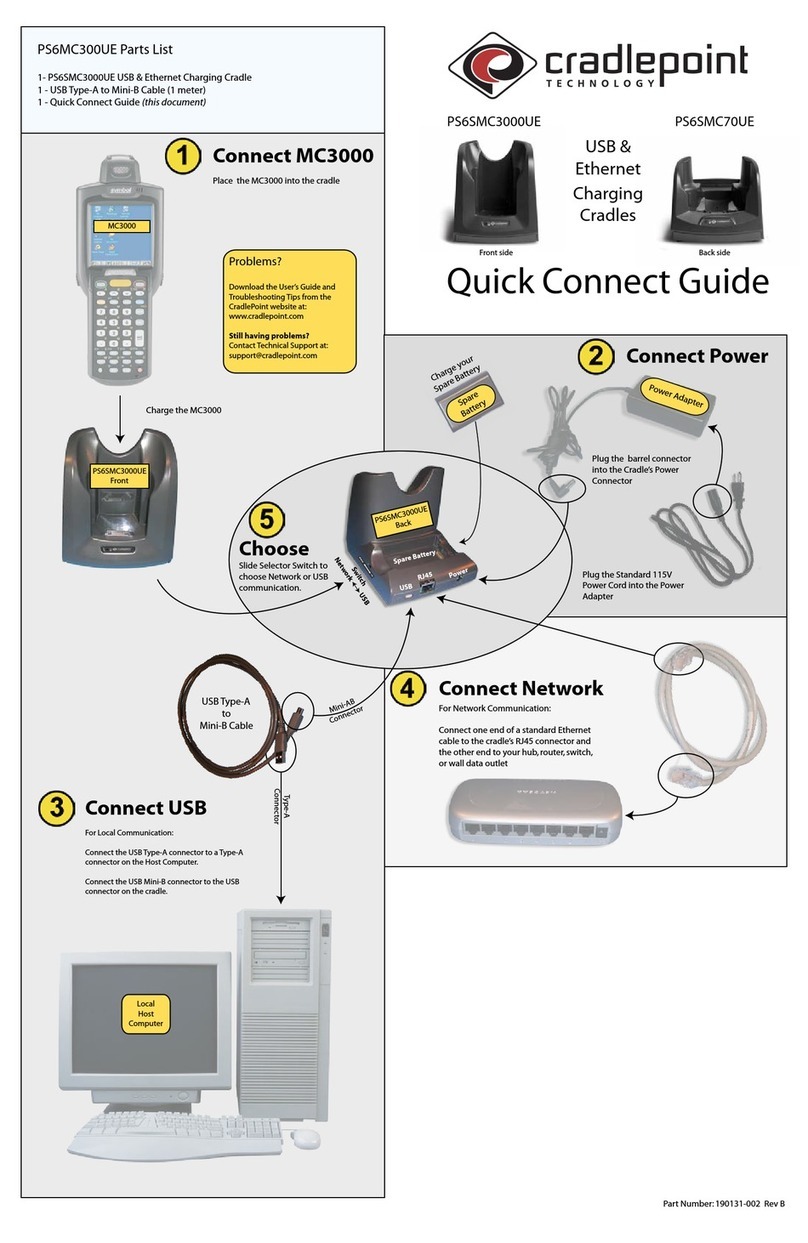Sens MicroGenius 2 User manual

SENS MicroGenius 2 Technical Manual
1
Installation & Operation Manual
180W: 12V, 10A; 24V, 6A
300W: 12V, 12A; 24V, 10A
450W: 12/24V, 15A
Genset, Marine & Stationary Battery
Charger
PATENTED US 9,270,140; 9,385,556; 9,413,186; 9,509,164;
PATENTS PENDING
Installation or service questions?
Call SENS between 8 a.m. and 5 p.m. (Mountain Time),
Monday through Friday, or visit our website.
Copyright © Stored Energy Systems LLC 2017
The SENS name / logo, MicroGenius, HELIX, and Dynamic Boost are trademarks of Stored Energy Systems LLC
SENS Part Number: 101324
Document Revision: J
DCN Number: 107448
Date: March 22, 2018
1840 Industrial Circle
Longmont, CO 80501
Phone:
303.678.7500
800.742.2326
Fax:
303.678.7504
Email:
service@sens-usa.com
Web:
www.sens-usa.com

SENS MicroGenius 2 Technical Manual
2
TABLE OF CONTENTS
1IMPORTANT SAFETY INSTRUCTIONS FOR INSTALLER AND OPERATOR................................................................................ 3
2MODEL NUMBER BREAKOUT................................................................................................................................................. 4
3PERFORMANCE SPECIFICATIONS ........................................................................................................................................... 5
4SYSTEM OVERVIEW.............................................................................................................................................................. 10
5MOUNTING INSTRUCTIONS ................................................................................................................................................. 11
5.1. Mounting Location............................................................................................................................................................... 11
5.2. Mounting Instructions ......................................................................................................................................................... 12
6CHARGER SETUP................................................................................................................................................................... 13
6.1. Factory Jumper Configuration.............................................................................................................................................. 13
6.2. Standard Jumper Configuration........................................................................................................................................... 14
6.3. Keypad Configuration—Optional ......................................................................................................................................... 16
6.4. Ultracapacitor Mode Setup.................................................................................................................................................. 16
6.5. Program Mode ..................................................................................................................................................................... 17
6.6. Load Share Charger Setup.................................................................................................................................................... 17
6.7. SAE J1939 Communications Setup (CANbus) ....................................................................................................................... 17
6.8. Modbus Communications Setup.......................................................................................................................................... 18
7WIRING................................................................................................................................................................................. 19
7.1. Wire Ratings and Sizes ......................................................................................................................................................... 20
7.2. Grounding Instructions and Connection .............................................................................................................................. 21
7.3. DC Connection ..................................................................................................................................................................... 21
7.4. AC Connection ..................................................................................................................................................................... 21
7.5. Alarm Connections—Optional ............................................................................................................................................. 21
7.6. Remote Temperature Sensor Connection—Optional .......................................................................................................... 23
7.7. J1939/Modbus Communications Connection...................................................................................................................... 23
7.8. Load Share Connection—Optional....................................................................................................................................... 24
7.9. Remote Alarm/Communications Panel Accessory Connection—Optional .......................................................................... 24
7.10. Verify Connections............................................................................................................................................................... 25
8POWER ON/POWER OFF PROCEDURE................................................................................................................................. 25
8.1. Connect Battery ................................................................................................................................................................... 25
8.2. Apply AC Input Voltage ........................................................................................................................................................ 25
8.3. Power Off............................................................................................................................................................................. 25
9ALARMS, LEDS AND DISPLAY ............................................................................................................................................... 25
9.1. LED Indicators ...................................................................................................................................................................... 25
9.2. Individual Alarm Relay Contacts—Optional ......................................................................................................................... 26
9.3. LCD Panel—Optional............................................................................................................................................................ 26
9.4. Alarm Definitions ................................................................................................................................................................. 26
10 OPERATION .......................................................................................................................................................................... 34
10.1. Charging Algorithms............................................................................................................................................................. 34
10.2. Float Mode........................................................................................................................................................................... 34
10.3. Dynamic Boost™ Mode........................................................................................................................................................ 35
10.4. HELIX Mode.......................................................................................................................................................................... 36
10.5. Ultracapacitor Mode............................................................................................................................................................ 37
10.6. Charging Low or Zero-volt Batteries .................................................................................................................................... 37
10.7. Commissioning Batteries ..................................................................................................................................................... 37
10.8. Battery Check....................................................................................................................................................................... 37
10.9. Keypad Operation ................................................................................................................................................................ 38
10.10. Program Mode..................................................................................................................................................................... 42
10.11. Temperature Compensation................................................................................................................................................ 42
10.12. Load Share Charger Operation............................................................................................................................................. 43
10.13. Remote Alarm/Communications Panel Accessory............................................................................................................... 44
11 J1939 COMMUNICATIONS ................................................................................................................................................... 44
11.1. J1939 Data Messages........................................................................................................................................................... 44
12 MODBUS COMMUNICATIONS............................................................................................................................................. 45
12.1. Modbus Holding Registers ................................................................................................................................................... 45
12.2. Status Definition .................................................................................................................................................................. 47
12.3. Alarm Bit Definition ............................................................................................................................................................. 48
12.4. Extended Status Bit Definition ............................................................................................................................................. 49
12.5. Writable Control Flags (Coils)............................................................................................................................................... 49
13 TROUBLESHOOTING/ERROR CODES .................................................................................................................................... 50
13.1. Configuration Error Codes ................................................................................................................................................... 50
13.2. Troubleshooting................................................................................................................................................................... 52
14 GLOSSARY............................................................................................................................................................................. 58

SENS MicroGenius 2 Technical Manual
3
1IMPORTANT SAFETY INSTRUCTIONS FOR INSTALLER AND OPERATOR
1.1. SAVE THESE INSTRUCTIONS – This manual contains important safety and operating instructions for
MicroGenius® 2 battery chargers.
1.2. Do not expose open-frame charger to rain or snow.
1.3. Use of an attachment not recommended or sold by the battery charger manufacturer may result in a risk of
fire, electric shock, or injury to persons.
1.4. This charger is intended for commercial and industrial use. ONLY TRAINED AND QUALIFIED PERSONNEL
MAY INSTALL AND SERVICE THIS UNIT.
1.5. Do not operate charger if it has received a sharp blow, been dropped, or otherwise damaged in any way;
shut off power at the branch circuit protectors and have the unit serviced or replaced by qualified
personnel.
1.6. To reduce risk of electric shock, disconnect the branch circuit feeding the charger before attempting any
maintenance or cleaning. Turning off controls will not reduce this risk.
1.7. WARNING – RISK OF EXPLOSIVE GASES
1.7.1. WORKING IN THE VICINITY OF A LEAD-ACID OR NICKEL-CADMIUM BATTERY IS DANGEROUS.
STORAGE BATTERIES GENERATE EXPLOSIVE GASES DURING NORMAL BATTERY OPERATION. FOR
THIS REASON, IT IS OF UTMOST IMPORTANCE THAT YOU READ THIS MANUAL AND FOLLOW THE
INSTRUCTIONS EACH TIME YOU USE THE CHARGER.
1.7.2. To reduce the risk of battery explosion, follow these instructions and those published by the battery
manufacturer and the manufacturer of any equipment you intend to use in the vicinity of a battery.
Review cautionary markings on these products and on the engine.
1.8. PERSONAL PRECAUTIONS
1.8.1. Someone should be within range of your voice or close enough to come to your aid when you work
near a storage battery.
1.8.2. Have plenty of fresh water and soap nearby in case battery electrolyte contacts skin, clothing, or
eyes.
1.8.3. Wear complete eye protection and clothing protection. Avoid touching eyes while working near a
storage battery.
1.8.4. If battery electrolyte contacts skin or clothing, wash immediately with soap and water. If electrolyte
enters eye, immediately flood the eye with running cold water for at least 10 minutes and get
medical attention immediately.
1.8.5. NEVER smoke or allow a spark or flame in vicinity of battery or engine.
1.8.6. Be extra cautious to reduce risk of dropping a metal tool onto the battery. It might spark or short
circuit the battery or another electrical part that may cause explosion. Using insulated tools reduces
this risk, but will not eliminate it.
1.8.7. Remove personal metal items such as rings, bracelets, necklaces, and watches when working with a
storage battery. A storage battery can produce a short circuit current high enough to weld a ring or
the like to metal, causing a severe burn.
1.8.8. When charging batteries, charge 6 and 12 cell LEAD-ACID or 10 and 20 cell LIQUID ELECTROLYTE
NICKEL-CADMIUM batteries only, with rated capacity of 30 to 300 Ampere hours.Charger certified
for fire pump and emergency generator applications at 200 Ampere hours. Do not use this battery

SENS MicroGenius 2 Technical Manual
4
charger to supply power to an extra-low voltage electrical system or to charge any type of non-
rechargeable, dry cell, alkaline, lithium, nickel-metal-hydride, or sealed nickel-cadmium batteries
that are commonly used with home appliances. These batteries may burst and cause injuries to
persons and damage to property.
1.8.9. NEVER charge a frozen battery.
1.8.10. The charger contains a DC output fuse for internal fault protection, but this will not protect the DC
wiring from fault currents available from the battery. Consult national and local ordinances to
determine if additional battery fault protection is necessary in your installation.
1.9. Preparing Battery For Charge
1.9.1. Be sure area around battery is well ventilated while battery is being charged.
1.9.2. Ensure battery terminals are clean and properly tightened. Be careful to keep corrosion from
coming in contact with eyes.
1.9.3. Add distilled water in each cell until battery acid reaches level specified by battery manufacturer.
Do not overfill. For a battery without removable cell caps, such as valve regulated lead acid
batteries, carefully follow manufacturer’s recharging instructions.
1.9.4. Study all battery manufacturer specific precautions such as removing or not removing cell caps
while charging and recommended rate of charge. The recommended charge current range must
include the rated output current of the charger.
1.10. Charger Location
1.10.1. Locate the charger as far away from the battery as DC cables permit.
1.10.2. Never place the charger directly above or below the battery being charged; gases from the battery
will corrode and damage charger.
1.10.3. Never allow battery acid to drip on charger when reading electrolyte specific gravity or filling
battery.
1.10.4. Do not operate charger in a closed-in area or restrict ventilation in any way.
1.10.5. Do not set anything on top of the charger.
2MODEL NUMBER BREAKOUT
M ---
Model
Power
1: 180W, enclosed
3: 300W, enclosed
4: 450W, enclosed
F: 180W, open-frame
G: 300W, open-
frame
H: 450W, open-frame
Output Voltage
22: 12/24 Volts
Output Current
1006: 10A @ 12V
6A @ 24V
(180W only)
1210: 12A @ 12V
10A @ 24V
(300W only)
1515: 15A @ 12V
15A @ 24V
(450W only)
Alarms/Communications*
A: base model; includes J-1939 & Modbus
D: base model + LCD + 5 Form C alarm relays
E: base model + LCD + 2 Form C alarm relays
F: base model + LCD + 5 Form C alarm relays + keypad
*LCD, Form C alarm relays and keypad not available on
open-frame charger. Remote accessory with these
options available as a separate line item for open-frame
chargers and option A enclosed chargers.

SENS MicroGenius 2 Technical Manual
5
3PERFORMANCE SPECIFICATIONS
MicroGenius® 2 is a switchmode, regulated, filtered, microprocessor-controlled, current limited battery charger
designed for heavy-duty industrial service. Chargers may be configured for three primary applications: 1) quick
recharge and long life maintenance of engine start batteries, 2) DC power supply and battery charging for marine
environments, and 3) DC power and standby battery charging for industrial control and safety systems. The
charger is provided as 180W, 300W or 450W models and in either fully enclosed or open-frame enclosures. Every
model provides 12V and 24V output voltage as well as J1939 and Modbus communications. Optional features
include alarm relays, easily readable alpha-numeric display and keypad. Charger specifications are detailed in the
table below, see following sections for installation and operation instructions.
Table 1 – Specifications
AC Input
Voltage, Frequency
90-265 VAC , 47-63 Hz
Current (maximum)
180W: 2.0 Amps
300W: 3.3 Amps
450W: 4.0 Amps
Protection
Supplementary overcurrent protection fuse (non-replaceable);
transient protected to EN61000-4-5 level 4
Efficiency
Up to 93%; meets CA Energy Commission (CEC) Title 20 Appliance
Efficiency Regulations; standby AC draw < 3W
Power factor
>.95 typical at maximum rated load current and boost charge voltage
60.0%
65.0%
70.0%
75.0%
80.0%
85.0%
90.0%
95.0%
0
1
2
3
4
5
6
7
8
9
10
11
12
13
14
15
16
Efficiency
Load (Amps)
Efficiency at 15VDC Output
115 VAC
230 VAC
60.0%
65.0%
70.0%
75.0%
80.0%
85.0%
90.0%
95.0%
0
1
2
3
4
5
6
7
8
9
10
11
12
13
14
15
16
Efficiency
Load (Amps)
Efficiency at 30VDC Output
115 VAC
230 VAC

SENS MicroGenius 2 Technical Manual
6
DC output
Voltage
12/24V nominal; field selectable; adjustable from 0-34V using
computer to charger cable and SENS Setup Utility Kit (SENS p/n
209254 plus SENS software available at www.sens-usa.com)
Current
180W: 10A at 12V nominal and 6A at 24V nominal, 180W maximum
300W: 12A at 12V nominal and 10A at 24V nominal, 300W maximum
450W: 15A at 12/24V nominal, 450W maximum (12A max below
170VAC input voltage in 24V configuration)
Soft start
Charger gradually increases current with a maximum of 5 seconds to
full-required output
Charging modes
Float voltage, boost voltage; two additional HELIX charging voltages in
flooded lead-acid battery program
Battery type programs
Flooded lead-acid, AGM or Ni-Cd for engine starting; VRLA for reserve
power; ultracapacitor
DC power supply
operation
Delivers fast-responding, stable, well-filtered DC without battery
Factory adjustment
All charger adjustments factory set to customer specifications; field
reconfigurable
Field voltage
adjustment
3 manually selectable voltage settings; optional keypad; infinite
adjustment using computer to charger cable and SENS Setup Utility
Kit (SENS p/n 209254 plus SENS software available at www.sens-
usa.com)
Current limit
100% current capability subject to temperature limits and AC voltage
limits on 450W; field adjustable
Charging characteristic
Constant voltage, current limited; patented Dynamic Boost control
Line/load regulation
+0.5%
Output ripple
<30mVrms with or without battery
Battery temperature
compensation
On-board sensor controls changes in output voltage when
temperature is between 0°C and +40°C at a rate of – 0.18% per
degree C; optional remote battery temperature probe (SENS p/n
209481)
Output protection
Current limit, supplementary overcurrent protection fuse (non-
replaceable), transient protected
Overvoltage protection
Self-resetting and selective
4
6
8
10
12
14
16
12.00
13.00
14.00
15.00
16.00
17.00
23.00
23.33
25.33
27.33
29.33
31.33
33.00
Output voltage
450W amps, 208-
240 VAC input
450W amps, 100-
120 VAC input
300W amps @
12V setting
300W amps @
24V setting
180W amps @
12V setting
180W amps @
24V setting
Output Current Limit vs. Output Voltage

SENS MicroGenius 2 Technical Manual
7
Dead battery charge
Starts into and recharges zero volt battery without user intervention
Parallel/Load Share
operation
Two or more load-sharing chargers operate with all modes
synchronized for increased current or fault tolerance, requires
standard RJ-45 network cable to connect paralleling bus (SENS p/n
208118-72 for 72-inch length or p/n 208118-180 for 180-inch length)
Load Dump protection
Output voltage over-shoot is limited to 15% to prevent damage to
connected devices if battery is disconnected while charger is
operating
Output Blocking
protection
Prevents sparking during battery connection when battery is first
connected to charger; serves as an "OR" diode to isolate a non-
functioning charger from others in a redundant charger configuration
Adjustment
& Controls
Charge mode control
Fully automatic patented Dynamic Boost system. Fully automatic
HELIX system for flooded lead-acid starting batteries that reduces
power use and extends battery life.
Internal adjustments
12 or 24 volt; battery type program; fine voltage setting
Battery type programs
Flooded lead-acid, AGM or Ni-Cd for engine starting; VRLA for reserve
power; ultracapacitor
Computer adjustment
Change or customize settings from computer using computer to
charger cable and SENS Setup Utility Kit (SENS p/n 209254 plus SENS
software available at www.sens-usa.com)
Keypad adjustment
Enable or change all settings from front panel (requires optional
keypad)
Status
display
LEDs
Dual multi-color front panel status LEDs
Digital metering
DC voltmeter accurate to +2%; DC ammeter to +5% (meters require
optional display or network connection to a compatible device with a
display). AC input voltage is for reference only. If AC waveform is not
sinusoidal or is distorted the AC voltage will not be reported
accurately.
Status messages
20-character display of status and alarm messages (requires optional
display or network connection to a compatible device with a display)
Alarms
Alarms
Factory set and field reconfigurable.
Output via network
Alarms available via either J1939 or Modbus ports. Alarm indication
delayed by configured alarm delay value.
Form C contacts
Two or five Form C contacts, each rated 30VDC/VAC, 2A resistive,
assignable at factory or by using SENS Setup Utility. Alarm indication
delayed by configured alarm delay value.
Alarm Delay
30 seconds by default, programmable between 5 to 60 seconds using
keypad or SENS Setup Utility. Alarm indication delayed for
communications ports and relay contacts, LED indication not delayed.
Networking
J1939 communications
CAN 2.0 extended ID on RJ-45 port
Modbus
communications
Modbus RS-485 on RJ-45 port
SENSbus
Proprietary bus for connection of paralleled chargers and future SENS
accessories

SENS MicroGenius 2 Technical Manual
8
Environ-
mental
Operating temperature
180W, enclosed: -40°C to +70°C; meets full specification from
-40°C to +55°C
180W, open-frame: -40°C to +70°C; meets full specification from -
40°C to +60°C
300W: -40°C to +70°C; meets full specification from -40°C to +50°C
450W: -40°C to +70°C; meets full specification from -40°C to +40°C
LCD: display may be unreadable and life reduced above 65°C
Cooling
Natural convection cooled
Storage temperature
-40°C to +85°C
Cold Start
Cold starts down to -40°C. Requires approximately five seconds
additional time to start at temperatures below -20°C.
Humidity
5% to 95%, non-condensing
Water ingress
Enclosed Models: IP 22; NEMA 3R; UL Rainproof
Vibration
Swept Sine (EN60068-2-6): 4G, 18-500 Hz, 3 primary axes
Random: 20-500Hz, .01G2/Hz
Shock
EN 60068-2-27 (15G)
Electrical transient
ANSI/IEEE C62.41 and EN 61000-4-12 on power terminals
Abuse
protection
Reverse polarity
Charger self-protects without fuse clearing; indication via LED and
optional LCD; charger recovers automatically after removal of the
fault condition
Wrong voltage battery
Charger-battery voltage mismatch shuts down charger after 5
minutes; indication via LED and optional LCD
Overvoltage shutdown
Selective; shutdown only operates if charger causes the overvoltage
condition. Overvoltage caused by an external voltage source does not
shut down the charger.
Over temperature
protection
Gradual output power reduction if heatsink temperature becomes
excessive
Regulatory
compliance
North America
C-UL-US Listed (enclosed chassis): CSA 22.2, No. 107.2; UL 1236, File
E109740 for category BBGQ and File EX6409 for categories BBHH,
BBJY and QWIR; certified to UL 1236 supplements SB (marine), SC
(fire pump) and SE (emergency generator) E109740
Note: 180W unit configured for 24V output is not compliant with
QWIR2
C-UL-US Recognized (open-frame chassis): CSA 22.2, No. 107.2; UL
1236, File E109740 for category BBGQ2 and File EX6409 for categories
BBHH2, BBJY2 and QWIR2; certified to UL 1236 supplements SC (fire
pump) and SE (emergency generator)
Note: 180W unit configured for 24V output is not compliant with
QWIR2
NFPA-70; NFPA-110 when annunciating to the genset control panel
the charger’s output voltage & current, and alarm status via J1939, or
when equipped with optional alarm relays
FCC: Part 15, Class B for home or commercial use and ICES-003
(Canada).
This device complies with part 15 of the FCC Rules. Operation is
subject to the following two conditions: (1) This device may not cause
harmful interference, and (2) this device must accept any
interference received, including interference that may cause
undesired operation.

SENS MicroGenius 2 Technical Manual
9
Seismic: rigid and non-structure wall mount; max S
DS
of 2.5G; IBC
2000-2015; California BC 2007-2016
American Bureau of Shipping: Type Approved
California Energy Commission: Title 20 Appliance Efficiency
Regulations
European Union (CE)
EMC: 2014/30/EU
EN 61000-6-4 (Emissions – Class B)
CISPR 11 – Class B
EN 61000-6-2 (Immunity – Industrial Environments)
EN 61000-4-2 Electro Static Discharge 4 kV contact, 8 kV air
EN 61000-4-3 Radiated Immunity – at 10V/m
EN 61000-4-4 Electrical Fast Transients – 2kV AC, 1kV I/O
EN 61000-4-5 Surge Immunity – 2 kV cm, 1 kV diff
EN 61000-4-6 Conducted power line immunity – 10 V r.m.s.
EN 61000-4-8 Power frequency magnetic field testing – 30 A/m
EN 61000-4-11 Voltage dips and interruptions – per the standard
LVD: 2014/35/EU
EN 60335-1 & EN 60335-2-29
RoHS 2: 2011/65/EU
EN 50581
WEEE: 2012/19/EU
This charger is considered electrical and electronic equipment (EEE)
for non-household use and should be recycled accordingly. Do not
dispose as unsorted municipal waste. See SENS website (www.sens-
usa.com) for information on how to properly recycle.
Construction
Housing/configuration
Enclosed chassis: die-cast aluminum heatsink base with stainless steel
covers and fasteners; includes two ½ inch conduit openings and one
¾ inch conduit opening
Open-frame chassis: aluminum heatsink base and cover
Dimensions
See drawings and dimensions at back of manual
Weight
Enclosed: 6.0 lbs (2.7 Kg)
Open-frame: 3.2 lbs (1.45 Kg)
Connections
AC and DC terminal blocks: 20 to 10 AWG solid copper; 20 to 6 AWG
stranded copper
J-1939 and Modbus-485: RJ-45
Form C alarms terminal block plug: 28 to 16 AWG

SENS MicroGenius 2 Technical Manual
10
4SYSTEM OVERVIEW
Fully enclosed model with optional alarm/communications circuit board shown. Refer to the nameplate label or
the label on the inside lower cover for factory configured output and alarm relay assignments.
OPTIONAL J1939 JUMPERS:
Select Charger 1 or 2 on
alarm/comms PCA, if included
OUTPUT JUMPERS:
Leave in Factory Configuration
(3 jumpers in FLOAT)
Move only if system voltage or
battery type change from
original factory configuration
Jumpers removed for adjustable
keypad or Program Mode
MAIN PCA J1939 ADDR
JUMPERS:
Select Charger 1 or 2 on
main PCA unless optional
alarm/comms PCA is included
OPTIONAL DUAL RJ-45
PORT:
Connect J1939/Modbus
cable if alarm/comms PCA
is included
MAIN PCA DUAL RJ-45 PORT:
Connect J1939/Modbus cable to
main PCA unless optional
alarm/comms PCA is included
Always connect load share or remote
accessory cable to main PCA
CONDUIT OR CORD
BUSHINGS:
Customer supplied
MOUNTING FASTENERS:
Use four ¼ inch (M6)
screws to mount enclosed
and open-frame chargers,
fasteners supplied by installer
MOUNTING:
Mount enclosed chassis
charger vertically
Mount open-frame
charger in any orientation
OPTIONAL LCD:
Status and alarms
AC STATUS LED
DC STATUS LED
AC INPUT TERMINALS:
20–10 AWG (0.5–6 mm2) solid
20–6 AWG (0.5–13.5 mm2) stranded
Tighten to 10.5 In-Lb (1.2 Nm)
OPTIONAL ALARM
TERMINAL BLOCKS:
28–16 AWG (0.08–1.5 mm2)
Tighten connections to 2.0
In-Lb (0.22 Nm)
REMOTE TEMPERATURE
SENSOR TERMINALS:
28–16 AWG (0.08–1.5 mm2)
Tighten connections to 2.0
In-Lb (0.22 Nm)
DC OUTPUT TERMINALS:
20–10 AWG (0.5–6 mm2) solid
20–6AWG (0.5–13.5 mm2) stranded
Tighten to 10.5 In-Lb (1.2 Nm)
GROUND FAULT JUMPER

SENS MicroGenius 2 Technical Manual
11
5MOUNTING INSTRUCTIONS
INSTALLATION OF THE UNIT MUST COMPLY WITH LOCAL ELECTRICAL CODES AND OTHER APPLICABLE
INSTALLATION CODES AND BE MADE ACCORDING TO THE INSTALLATION INSTRUCTIONS AND ALL
APPLICABLE SAFETY REGULATIONS.
Printed circuit boards contain static sensitive components. Damage can occur even when static levels are too
low to produce a noticeable discharge shock. To avoid static discharge damage, handle the charger by the
chassis only. Remove the cover only when access is essential for installation and service, and replace it
promptly when finished.
5.1. Mounting Location
The charger is provided in two different chassis options, fully enclosed or open-frame. See diagrams at
back of manual for mounting information.
5.1.1. Enclosed Chassis
5.1.1.1. The fully enclosed charger is rated IP22 and is approved as “rainproof” by UL. It can withstand
dripping liquid but may require additional protection from spraying, splashing, or blowing
liquid.
5.1.1.2. The charger will operate at full specification when located where temperatures are within the
following ranges. Output power is gradually reduced at higher temperatures.
Power
Rating
Operating Temperature
180W
-40°C (-40°F) to +55°C (131°F)
300W
-40°C (-40°F) to +50°C (122°F)
450W
-40°C (-40°F) to +40°C (104°F)
5.1.1.3. Mount charger vertically to ensure adequate ventilation.
5.1.1.4. Leave clear space for ventilation all around the enclosed unit: at least 6 inches (15 cm) at the
top; at least 4 inches (10.16 cm) at the bottom; at least 0.5 inches (1.27 cm) on each side.
Operating temperature ranges stated above assume clearances shown in diagram below.
5.1.1.5. Mount to a wall or other vertical support. The mounting surface must safely support the
weight of the charger and the fixed wiring. The weight of the enclosed charger is 6 pounds
(2.7 Kg).
5.1.2. Open-frame Chassis
5.1.2.1. The open-frame chassis charger is designed for installation inside a customer-provided
enclosure, protected from rain, snow and blowing or dripping liquid.
5.1.2.2. Heat sink the charger to a metal surface that is not subject to heating from another source.
Base plate temperature should not exceed 83°C measured at top front of base plate when

SENS MicroGenius 2 Technical Manual
12
charger is operating at full current load and maximum ambient temperature.
5.1.2.3. The charger will operate at full specification when located where temperatures are within the
following ranges. Output power is gradually reduced at higher temperatures.
Power
Rating
Operating Temperature
180W
-40°C (-40°F) to +60°C (140°F)
300W
-40°C (-40°F) to +50°C (122°F)
450W
-40°C (-40°F) to +40°C (104°F)
5.1.2.4. Mount charger in any orientation.
5.1.2.5. The mounting surface must safely support the weight of the charger and the fixed wiring. The
weight of the open-frame charger is 3.2 pounds (1.45 Kg).
5.1.3. Allow sufficient room for routing the fixed wiring to the charger. All wires enter the charger from
the bottom. See diagrams at back of manual for further information.
5.1.4. Do not mount the charger above any heat generating equipment.
5.2. Mounting Instructions
5.2.1. Drill four mounting holes using the mounting template provided with the charger.
IMPORTANT: Protect charger from all drill shavings!
5.2.2. Mount the charger before connecting AC, DC, communications and alarm wiring to ensure un-
obstructed access to mounting holes.
5.2.3. Mount the charger using four ¼ inch (M6) screws with standard flat washers. Mounting hardware
is not included with the charger and must be provided by the installer.

SENS MicroGenius 2 Technical Manual
13
6CHARGER SETUP
IMPORTANT! The charger is configured at the factory and typically requires no adjustments before operating.
Leave the jumpers in the three FLOAT positions to operate the charger using settings configured at the factory per
customer order. Refer to the label on the inside lower cover for factory configured output and alarm relay
assignments (see Figure 3). If the system voltage or battery type is different than the factory configuration, or if
other custom settings are required, the charger may be reconfigured using the jumpers, the optional front panel
keypad, or by software programming using the SENS Setup Utility.
Figure 1 – Jumper Settings
(fully enclosed model with optional alarm/communications circuit board shown)
6.1. Factory Jumper Configuration
The charger is shipped from the factory with three jumpers in the three FLOAT positions on the main
circuit board. Jumpers in the three FLOAT positions indicate the charger is operating using settings
configured at the factory per customer order. Refer to the label on the inside lower cover for factory
configured output and alarm relay assignments (see Figure 3). Leave jumpers in the factory
configuration unless system voltage or battery type changes.
Figure 2 – Factory Configuration
OPTIONAL J1939
JUMPERS:
Select Charger 1 or 2
on alarm/comms
PCA if included
OUTPUT JUMPERS:
Leave in Factory
Configuration (3
jumpers in FLOAT)
Move only if system
voltage or battery type
change from original
factory configuration
Jumpers removed for
adjustable keypad or
Program Mode
MAIN PCA J1939 ADD
JUMPERS:
Select Charger 1 or 2
on main PCA unless
optional alarm/comms
PCA is included
GROUND FAULT JUMPER

SENS MicroGenius 2 Technical Manual
14
Figure 3 – Configuration Label (on inside lower cover)
6.1.1. Changing Voltage Range Using Factory Jumpers Mode
The voltage range (12-volt or 24-volt battery) of the charger may be changed without changing
factory settings by moving any one of the three FLOAT jumpers to the appropriate RANGE
position. Set the RANGE jumper to 12V or 24V depending on nominal battery voltage. Leave the
other two jumpers in the FLOAT positions. In this configuration the charging algorithm, output
settings and alarm relay assignments remain as originally configured at the factory but all
setpoints are doubled when changing from a 12V setting to a 24V setting or halved when
changing from a 24V setting to a 12V setting. Replacing the jumpers in the three FLOAT positions
will return the charger to original factory configuration.
Figure 4 – Change System Voltage
6.1.2. Changing Battery Type Using Jumpers
If battery type changes from original factory configuration, the Standard Jumper Configuration
must be used (see section 6.2).
6.2. Standard Jumper Configuration
If battery type changes from the original factory configuration all jumpers must be moved into the
standard jumper configuration - one jumper each in BATTERY TYPE, FLOAT and RANGE positions. In this
configuration the alarm relay assignments remain as originally configured at the factory. Replacing the
jumpers in the three FLOAT positions will return the charger to original factory configuration.
View output voltage,
battery type and
configuration code
set at the factory
View alarm relay
assignments set
at the factory

SENS MicroGenius 2 Technical Manual
15
Figure 5 – Standard Jumper Configuration
6.2.1. Battery Type Jumper
Set the BATTERY TYPE jumper appropriate for the battery type used.
Table 2 – Charging Algorithms by Battery Type
Battery Type
Charging Algorithm
Float
Mode
Dynamic
Boost Mode
HELIX
Mode
FLA
AGM
NICD
VRLA
6.2.1.1. FLA
This setting is ideal for flooded lead-acid batteries used in engine starting applications. Set
the BATTERY TYPE jumper to FLA when using flooded lead-acid batteries. The charging
algorithm for flooded lead-acid batteries includes Float mode (see section 10.2), Dynamic
Boost™ mode (see section 10.3) and HELIX mode (see section 10.4).
6.2.1.2. AGM
The term, “AGM” in this manual and for the MicroGenius charger refers to AGM type
batteries that are employed in engine starting applications. For AGM type batteries
employed in non-engine starting applications please see “VRLA” in section 6.2.1.4 below. Set
the BATTERY TYPE jumper to AGM when using engine starting AGM batteries. . The charging
algorithm for absorbed glass mat batteries includes Float mode (see section 10.2) and
Dynamic Boost™ mode (see section 10.3).
6.2.1.3. NICD
Set the BATTERY TYPE jumper to NICD when using nickel-cadmium batteries. The charging
algorithm for nickel-cadmium batteries includes Float mode (see section 10.2) and Dynamic
Boost™ mode (see section 10.3). Nickel-cadmium batteries are used in all applications.
6.2.1.4. VRLA
The “VRLA” battery profile includes all valve regulated batteries, including AGM types, which
are employed in non-engine starting applications. For AGM batteries employed in engine
starting applications please see “AGM” in section 6.2.1.2 above. Set the BATTERY TYPE
jumper to VRLA when using valve-regulated lead-acid batteries, of which AGM is a subset.
The charging algorithm for valve-regulated lead-acid batteries includes Float mode only (see
section 10.2).

SENS MicroGenius 2 Technical Manual
16
6.2.1.5. Ultracapacitors
Place one jumper each in the AGM and NICD battery type positions and leave one jumper in
the RANGE position if charging ultracapacitors rather than batteries (see section 10.5).
6.2.2. Float Voltage Jumpers
When the charger is in Float mode the output voltage is maintained at the float voltage setting. If
adjustment from the factory set float voltage is necessary, move the FLOAT output voltage
jumper to the setting that is closest to the battery manufacturer’s recommended 25°C (77°F) float
voltage. Incorrect charge voltage can undercharge or accelerate generation of explosive gases,
increasing the risk of fire or explosion.
Jumper options:
14.3/28.6 volts for 10 or 20 cell nickel cadmium at 1.43V/cell
13.5/27.0 volts for 6 or 12 cell (VRLA, AGM or high capacity) lead-acid at 2.25V/cell and 19
cell nickel cadmium at 1.42V/cell
13.3/26.6 volts for 6 or 12 cell (flooded) lead-acid at 2.22V/cell and 19 cell nickel cadmium
at 1.40V/cell
The FLOAT output voltage setting is not used for charging ultracapacitors (see section 6.4 for
ultracapacitor setup).
6.2.3. Range Jumper
Set the RANGE jumper to 12V or 24V depending on nominal battery voltage.
6.3. Keypad Configuration—Optional
Charger adjustment may also be made using the optional keypad. The keypad is either integral to the
charger or located remotely from the charger and connected with a network cable. See section 7.9 for
more information on the Remote Alarm/Communications Panel Accessory. Chargers including a keypad
are supplied without jumpers and are configured per customer order at the factory. Jumpers must not
be present to allow adjustment using the keypad. See section 10.9for additional details on keypad
navigation.
6.3.1. Security Code Protection
Chargers with the optional keypad may be security code protected to ensure only authorized
personnel may adjust charger settings. The default security code is 000000 meaning security code
is not enabled. Change the security code to a unique value by scrolling to the “Service Tools”
menu and then the “Change Security Code” option.See section 10.9 for further keypad
information.
6.4. Ultracapacitor Mode Setup
Ultracapacitor mode is used to charge ultracapacitors rather than batteries. Place a jumper in the 12V or
24V RANGE position and jumpers in both the AGM and NICD battery type positions (no jumpers are
placed in the FLOAT settings) to enable operation with ultracapacitors.
WARNING:
ULTRACAPACITORS ACCEPT AND DISCHARGE CURRENT RAPIDLY. NEVER ATTEMPT TO
JUMP OR CONNECT A BATTERY TO AN ULTRACAPACITOR.

SENS MicroGenius 2 Technical Manual
17
Figure 6 – Ultracapcitor Mode Jumper Configuration
6.5. Program Mode
Removing all jumpers from the BATTERY TYPE, FLOAT and RANGE positions enables Program Mode. In
Program Mode the charger output is determined by values programmed in the charger using the SENS
Setup Utility (see section 10.10). If the charger has not been specially programmed, removing all jumpers
will result in an error state and the charger will not produce output. If the charger includes the optional
keypad removing the jumpers is required to adjust settings and will not result in an error state (see
section 6.3).
6.6. Load Share Charger Setup
Multiple chargers may be connected in parallel to provide charger redundancy and increased charging
current. Connection of a network cable between up to 30 chargers (see section 7.8) automatically
initiates load sharing. Use of this sharing cable is essential to synchronizing operation of the Dynamic
Boost and HELIX modes, and helps insure that current is shared within +10% between chargers. Remove
the ADD jumper from the main circuit board of any charger connected to load share (see Figure 8).
Chargers intended for load sharing must be configured with the same output settings in order to load
share. See section 10.12for further information.
6.6.1. Load Share Termination
For proper load share operation, a 120-ohm terminator is required at the ends of the bus. Figure
9 below shows an example of how to terminate the network. The charger is not equipped with
terminators. Termination may be provided as part of the network cabling or 120-ohm
termination plugs for the RJ-45 communications connector on the charger are available to order
separately (SENS p/n 803707).
6.7. SAE J1939 Communications Setup (CANbus)
Every charger includes SAE J1939 (CANbus) communications. The J1939 interface provides a highly
reliable, low cost method of delivering to the genset controller all information that NFPA 110 requires
the battery charger to deliver. This eliminates the need for a volt/amp display and alarm relays in the
charger. To be operational, the genset controller must support the charger’s J1939 connection. Contact
your genset supplier to determine if your genset supports a J1939-connected charger. See section 10.14
for further information on J1939 operation and registers.
6.7.1. Battery Charger J1939 Address Jumper
Configure the address jumper on the optional alarm/communications circuit board if present (see
Figure 7). Otherwise, configure the address jumper on the main circuit board (see Figure 8).
J1939 supports two chargers per network cable. Set the address jumper to position 1 for main
charger or position 2 for auxiliary charger. The jumper is set to position 1 by default.

SENS MicroGenius 2 Technical Manual
18
Figure 7 – Optional Circuit Board J1939 Battery Charger (BCH) Jumper
Figure 8 – Main Circuit Board J1939 ADD Jumper
6.7.2. Termination
For proper J1939 operation, a 120-ohm terminator is required at the ends of the J1939 bus. If
multiple devices are on the bus, only the devices on the ends of the network bus need
termination resistors. Figure 9 shows an example of how to terminate the network. The charger is
not equipped with terminators. Termination may be provided as part of the network cabling or
120-ohm termination plugs for the RJ-45 communications connector on the charger are available
to order separately (SENS p/n 803707).
Figure 9 – J1939 Termination
6.8. Modbus Communications Setup
Every charger includes Modbus (RS-485) communications. Modbus is an application layer messaging
protocol used for client/server communication and is implemented according to specifications provided
by Modbus Organization (http://www.modbus.org/specs.php). Modbus communications settings must
be configured using the optional keypad or SENS Setup Utility prior to initiating. See section 10.15for
further information on Modbus operation and configuration.
6.8.1. Termination
For proper Modbus RS-485 operation, a 120-ohm terminator is required at the ends of the RS-485
bus. If multiple devices are on the bus, only the devices on the ends of the network bus need
termination resistors. Figure 10 shows an example of how to terminate the network. The charger
is not equipped with terminators. Termination may be provided as part of the network cabling or
120-ohm termination plugs for the RJ-45 communications connector on the charger are available
to order separately (SENS 803707).

SENS MicroGenius 2 Technical Manual
19
Figure 10 – Modbus Termination
LT = Line Termination 120-ohm resistor
7WIRING
All wiring must comply with applicable codes and local ordinances.
WARNING:
ENSURE THAT AC POWER IS DISCONNECTED AT A CIRCUIT BREAKER
OR OTHER SAFETY DISCONNECT BEFORE WIRING THE CHARGER
Figure 11 – Wire Connections
(Fully enclosed model with optional alarm/communications circuit board shown)
OPTIONAL ALARM
TERMINAL BLOCKS:
28–16 AWG (0.08–1.5 mm2)
Tighten connections to 2.0
In-Lb (0.22 Nm)
OPTIONAL RJ-45 PORT:
Connect J1939/Modbus
cable if alarm/comms
PCA is included
CONDUIT OR CORD
BUSHINGS:
Customer supplied
DC OUTPUT TERMINALS:
20–10 AWG (0.5–6 mm2)
solid
20–6AWG (0.5–13.5 mm2)
stranded
Tighten to 10.5 In-Lb (1.2 Nm)
AC INPUT TERMINALS:
20–10 AWG (0.5–6 mm2) solid
20–6AWG (0.5–13.5 mm2)
stranded
Tighten to 10.5 In-Lb (1.2 Nm)
AC L2/N
GND
DC NEG (-)
REMOTE TEMPERATURE
SENSOR TERMINALS:
28–16 AWG (0.08–1.5 mm2)
Tighten connections to 2.0
In-Lb (0.22 Nm)
MAIN PCA RJ-45 PORT:
Connect J1939/Modbus cable to main PCA
unless optional alarm/comms PCA is included
Always connect load share or remote accessory
cable to main PCA
AC L1
DC POS (+)

SENS MicroGenius 2 Technical Manual
20
7.1. Wire Ratings and Sizes
7.1.1. All power conductors should be rated for use at 90°C or higher and 400V or higher. Alarm relay
conductors and J1939 data cable should be rated for use at 75°C or higher.
7.1.2. Coordinate the AC input conductor size with the customer-provided branch circuit protection
device.
7.1.3. For best performance and recharge time, refer to the following table to determine the
appropriate output conductor gauge and length. Use of a remote temperature sensor (SENS p/n
209481, see section 7.6) is highly recommended for best charging performance.
Table 3 – DC Output Cable Size
Charger Rated
Output Current
(Amps)
Wire Size
Resistance
per Foot
(mΩ/Ft.)
Maximum Charger to
Battery Distance (Ft.)
Recommended Charger to
Battery Distance (Ft.)
AWG
mm2
12V
24V
12V
24V
6
14
2.5
2.50
N/A
33
N/A
13
12
4.0
1.60
N/A
52
N/A
21
10
6.0
1.00
N/A
83
N/A
33
8
10
0.63
N/A
132
N/A
53
6
16
0.40
N/A
208
N/A
83
10
14
2.5
2.50
10
20
4
8
12
4.0
1.60
16
32
6
12
10
6.0
1.00
25
50
10
20
8
10
0.63
40
80
15
30
6
16
0.40
63
126
24
48
12
14
2.5
2.50
8
N/A
3
N/A
12
4.0
1.60
13
N/A
5
N/A
10
6.0
1.00
21
N/A
8
N/A
8
10
0.63
33
N/A
13
N/A
6
16
0.40
52
N/A
21
N/A
15
14
2.5
2.50
6
12
2
4
12
4.0
1.60
10
20
4
8
10
6.0
1.00
17
34
7
14
8
10
0.63
26
52
11
22
6
16
0.40
42
84
17
34
The above lengths consider the resistance of the battery and cables only and do not take into account any additional
interconnects. The above lengths are for operation at 25°C/77°F. For high temperature installations (40°C/104°F) increase wire
gauge by 10%.
7.1.4. The charger terminal blocks accept the following wire gauge ranges:
AC input terminal block: 20 – 10 AWG (0.5 – 6 mm2) solid; 20 – 6 AWG (0.5 – 13.5 mm2)
stranded
Remote temperature sensor terminal block: 28 – 16 AWG (0.08 – 1.5 mm2)
DC output terminal block: 20 – 10 AWG (0.5 – 6 mm2) solid; 20 – 6 AWG (0.5 – 13.5 mm2)
stranded
Alarm terminal block: 28 – 16 AWG (0.08 – 1.5 mm2)
Other manuals for MicroGenius 2
1
Table of contents
Other Sens Batteries Charger manuals

Sens
Sens MicroGenius S2 User manual
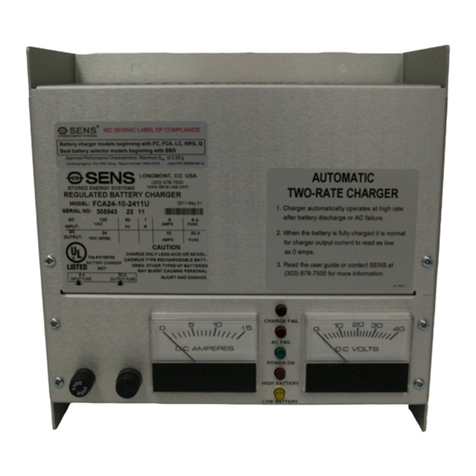
Sens
Sens FC Operating manual
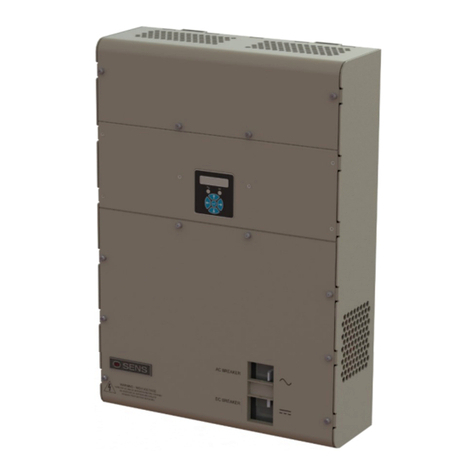
Sens
Sens EnerGenius DC Wallbox User manual

Sens
Sens MicroGenius User manual
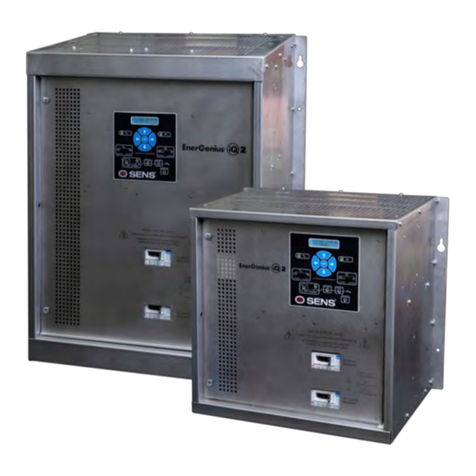
Sens
Sens EnerGenius IQ2 User manual

Sens
Sens EnerGenius NRG12-20 User manual
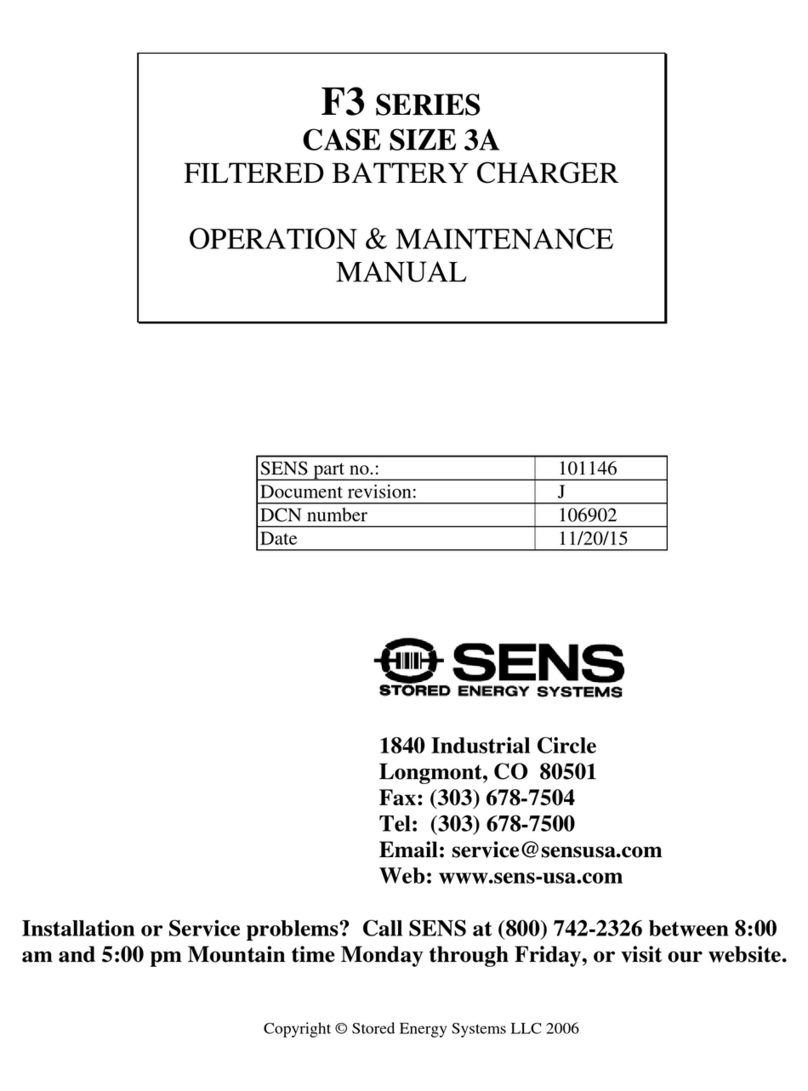
Sens
Sens F3 SERIES Manual
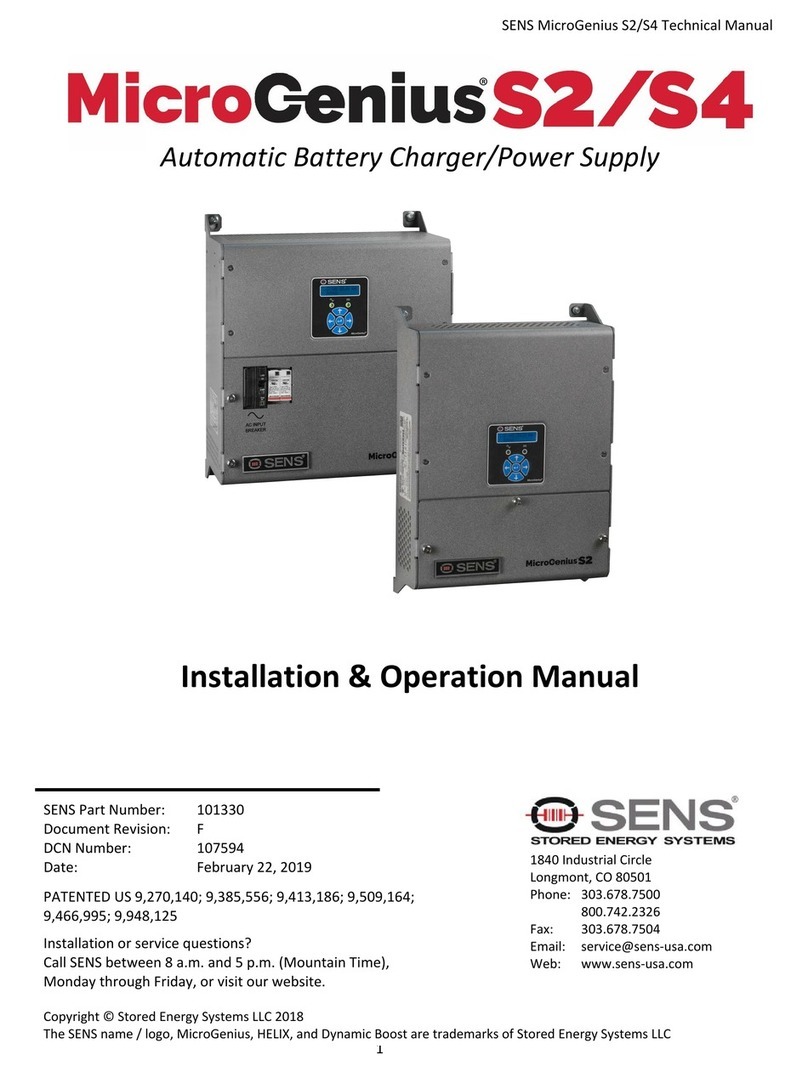
Sens
Sens MicroGenius S2 User manual

Sens
Sens F3 SERIES Manual
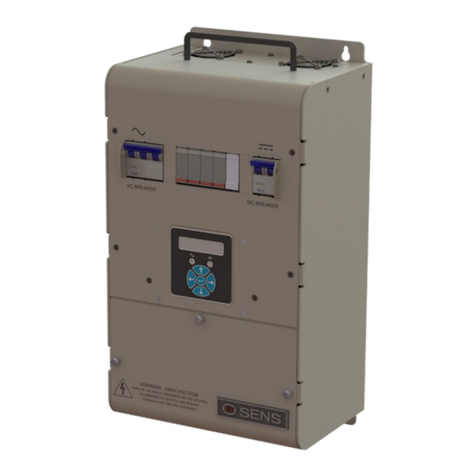
Sens
Sens EnerGenius DC COMPACT User manual

Sens
Sens NRG12-10 User manual

Sens
Sens Q012-012 User manual
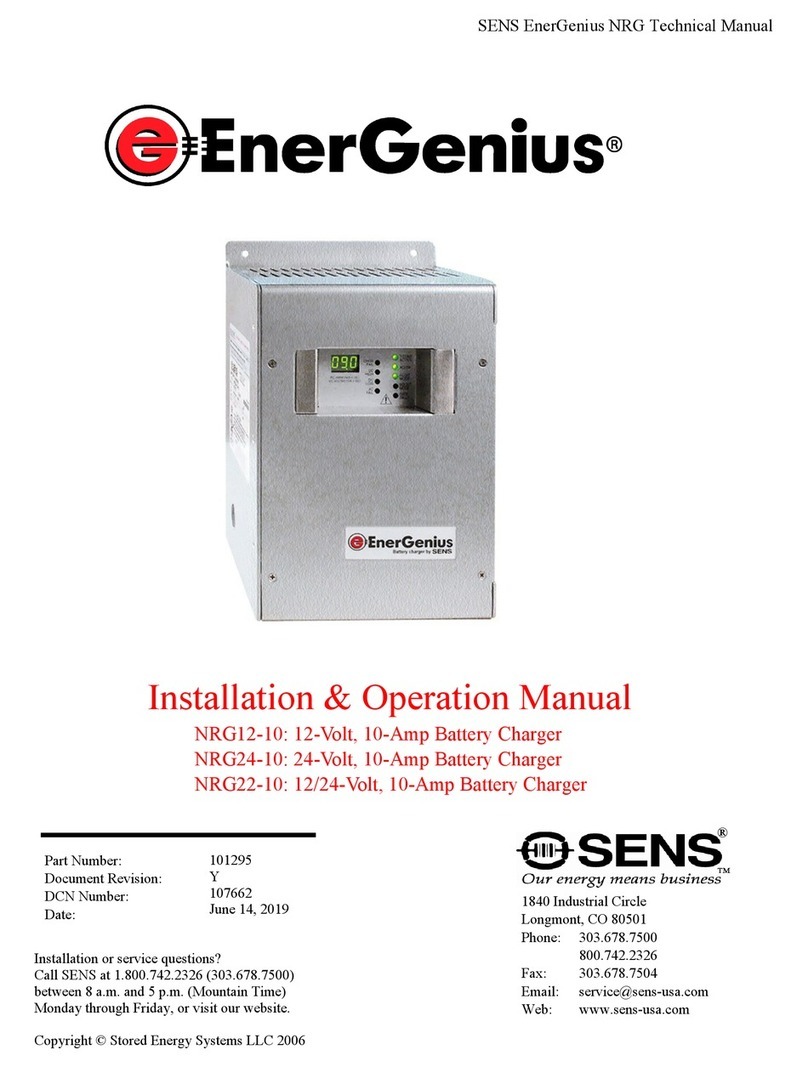
Sens
Sens EnerGenius NRG24-10 User manual
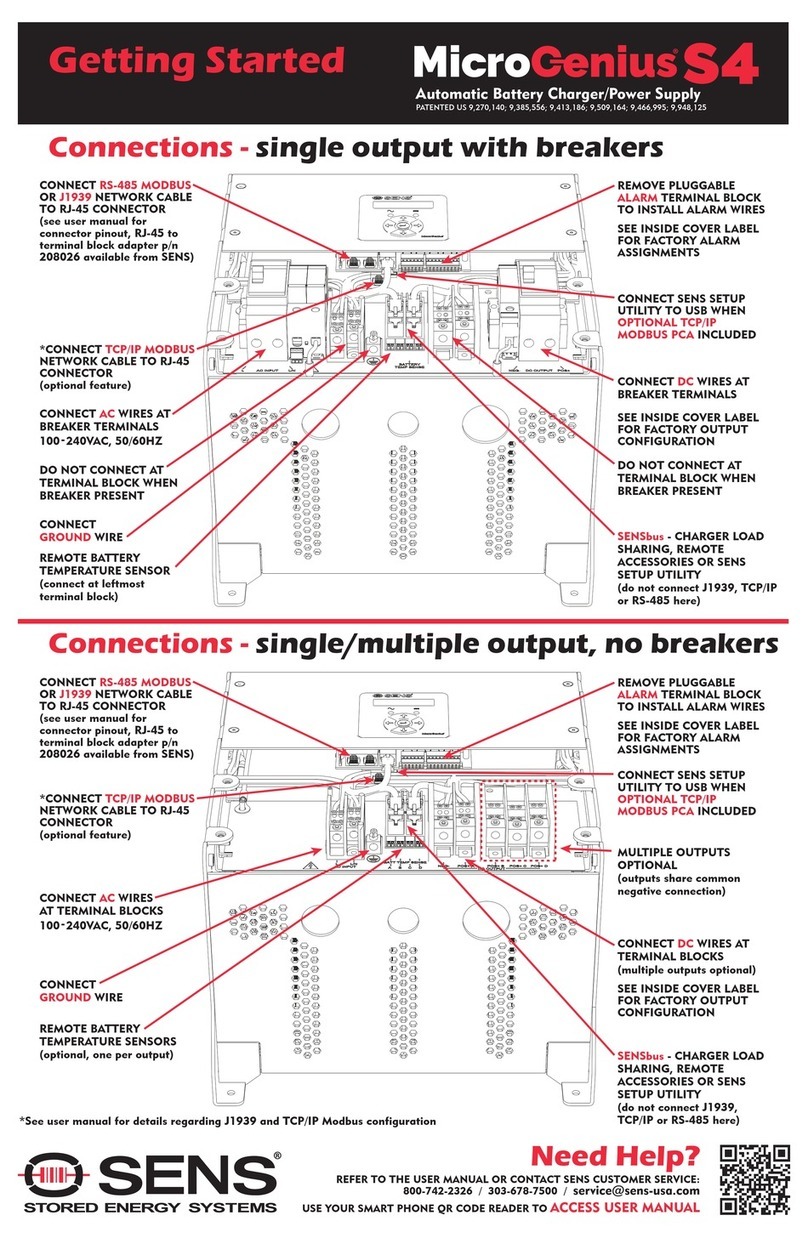
Sens
Sens MicroGenius S4 User manual
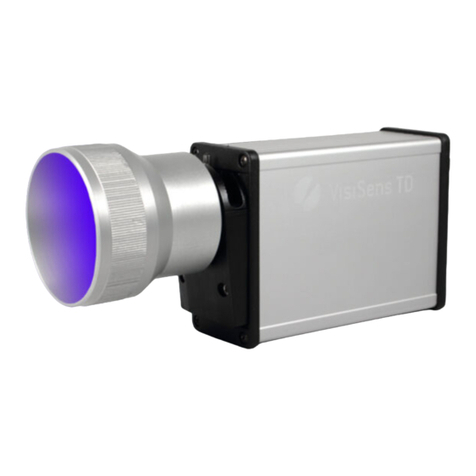
Sens
Sens TD Series Operating manual

Sens
Sens EnerGenius NRG22-20 User manual

Sens
Sens DCT Series Operating manual
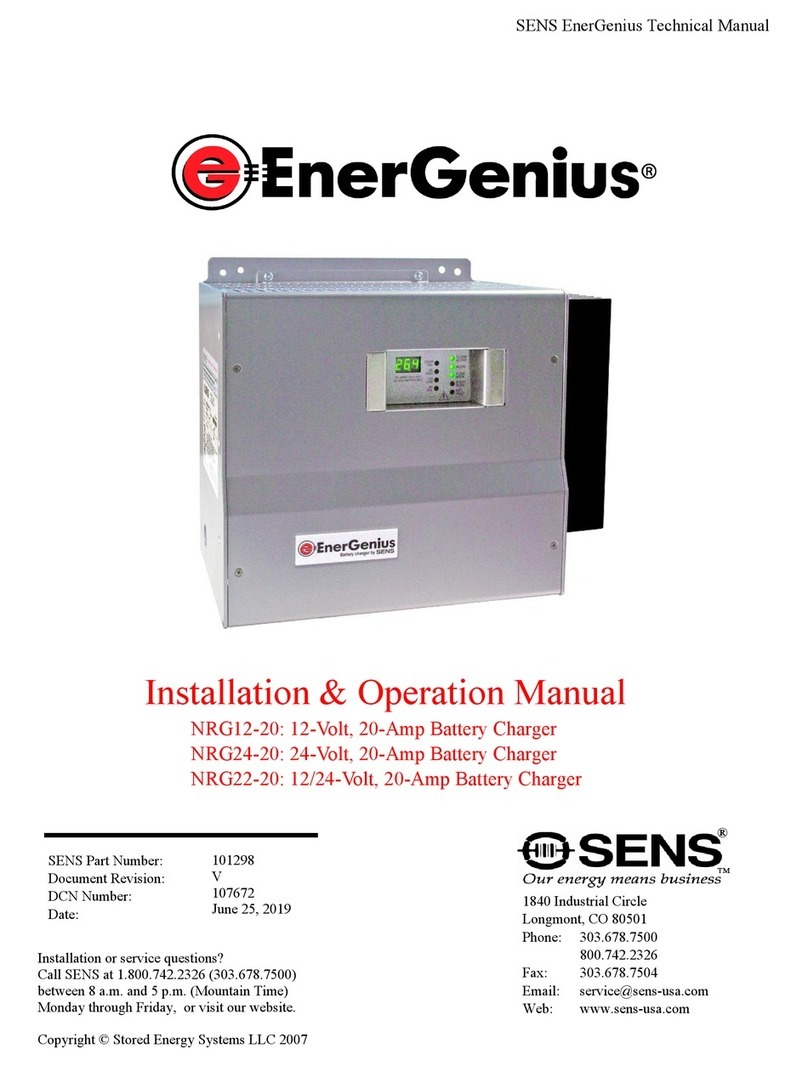
Sens
Sens EnerGenius NRG24-20 User manual
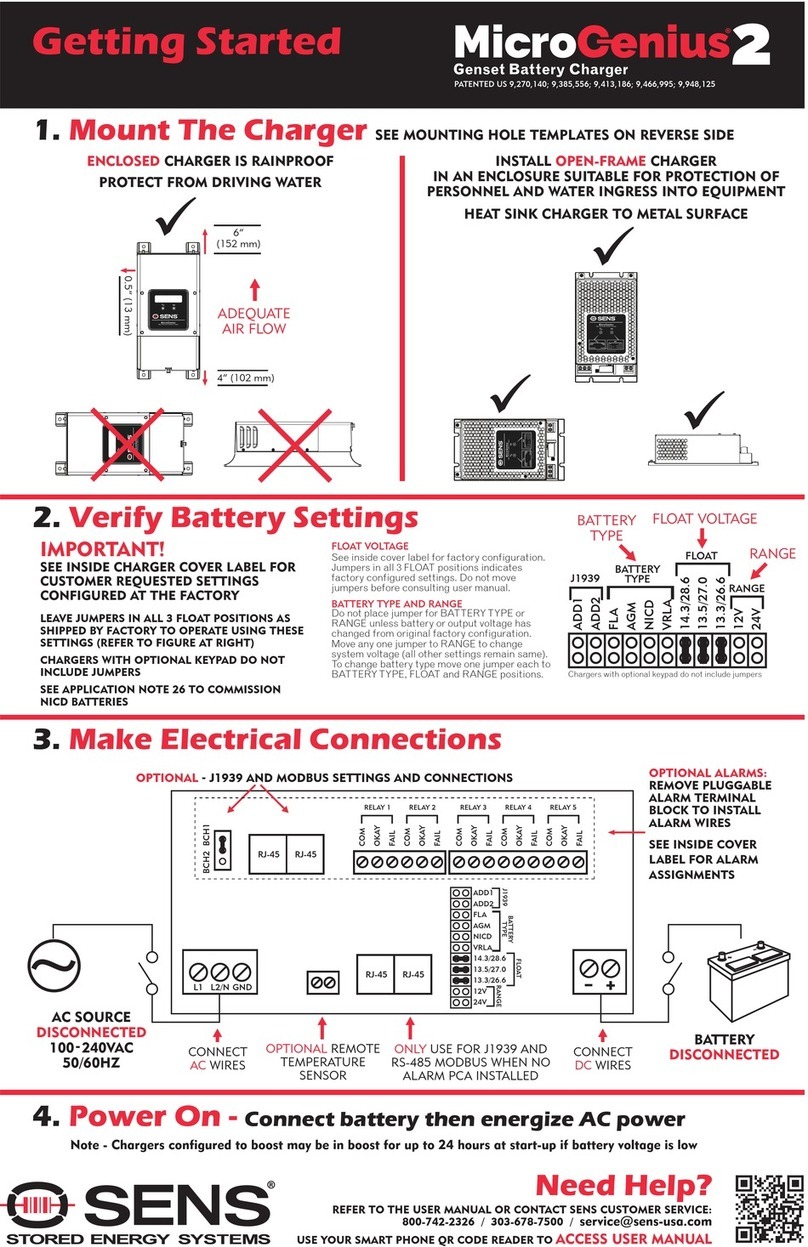
Sens
Sens MicroGenius 2 User manual
